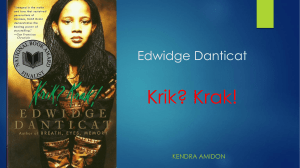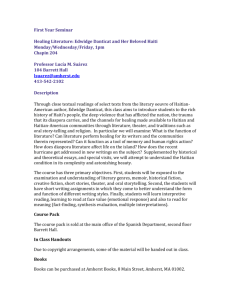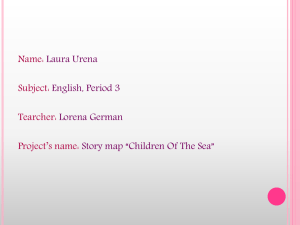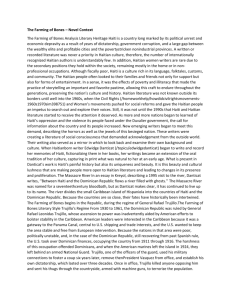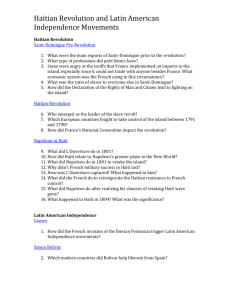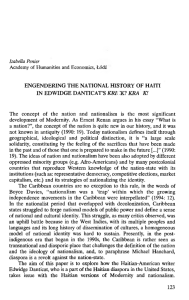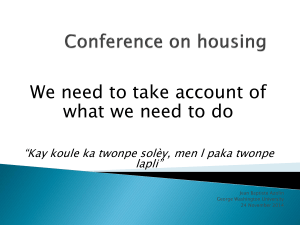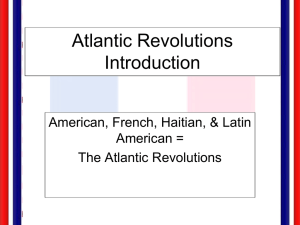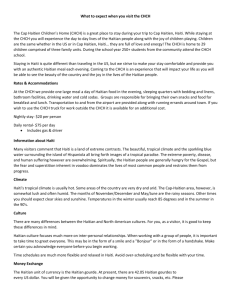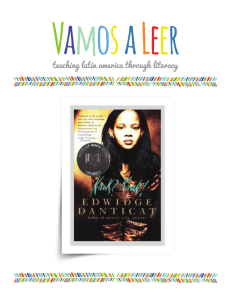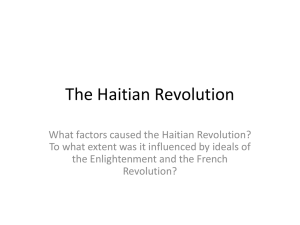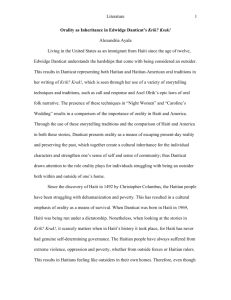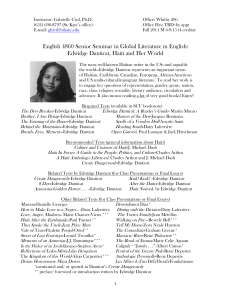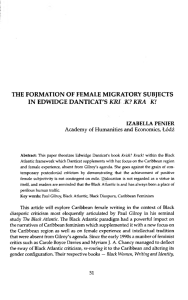English 490 – Paper 2
advertisement
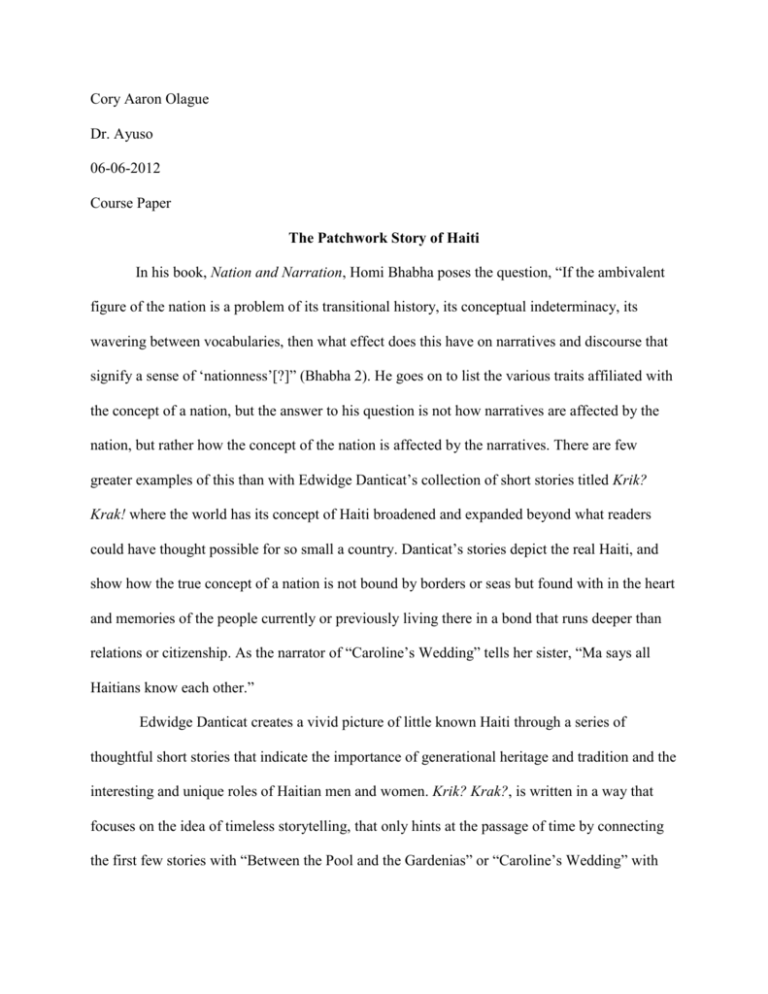
Cory Aaron Olague Dr. Ayuso 06-06-2012 Course Paper The Patchwork Story of Haiti In his book, Nation and Narration, Homi Bhabha poses the question, “If the ambivalent figure of the nation is a problem of its transitional history, its conceptual indeterminacy, its wavering between vocabularies, then what effect does this have on narratives and discourse that signify a sense of ‘nationness’[?]” (Bhabha 2). He goes on to list the various traits affiliated with the concept of a nation, but the answer to his question is not how narratives are affected by the nation, but rather how the concept of the nation is affected by the narratives. There are few greater examples of this than with Edwidge Danticat’s collection of short stories titled Krik? Krak! where the world has its concept of Haiti broadened and expanded beyond what readers could have thought possible for so small a country. Danticat’s stories depict the real Haiti, and show how the true concept of a nation is not bound by borders or seas but found with in the heart and memories of the people currently or previously living there in a bond that runs deeper than relations or citizenship. As the narrator of “Caroline’s Wedding” tells her sister, “Ma says all Haitians know each other.” Edwidge Danticat creates a vivid picture of little known Haiti through a series of thoughtful short stories that indicate the importance of generational heritage and tradition and the interesting and unique roles of Haitian men and women. Krik? Krak?, is written in a way that focuses on the idea of timeless storytelling, that only hints at the passage of time by connecting the first few stories with “Between the Pool and the Gardenias” or “Caroline’s Wedding” with Olague |2 “Children of the Sea.” The narrative maintains an extremely personal aspect appealing to many readers due to its Storyteller-like style with each story focusing on a singular event that drives the plot. Danticat’s collection of stories depicts neatly what was previously unknown to people outside Haiti: the reality and harshness of Haitian life and the true appreciation for living. In the Haitian nation the importance of passing down lessons and traditions through generations is held above almost all other things. This importance lies in honoring the memory of relatives passed as in the short story “1937” or the thoughtful consideration of lessons handed down from mother to daughter as in “New York Day Women” or “Caroline’s Wedding.” Each of these stories contain pieces of Haitian tradition as well as belief and superstition. “1937” tells the story of a young woman going to visit her imprisoned mother. Through the course of the story the reader is introduced simultaneously to generational history and tradition. Josephine, the narrator, tells of her pilgrimage to the Massacre River with her mother and her mother’s words show the respect of those loved ones past, “Here is my child, Josephine. We were saved from the tomb of this river when she was still in my womb. You spared us both, her and me, where I lost my mother” (Danticat 40). The passage and the story as a whole shows the great deal of respect and honor placed upon those who came before. “1937” provides evidence of a greater comprehension of who truly was responsible for the lives of new generations in a way that feels unique to Haiti. This idea is reciprocated by the older generations by the plethora of proverbs mothers and fathers tell their daughters and sons to lend their experience and wisdom to their children’s lives. Proverbs and aphorisms hold a large role in Haitian culture; the concept of passing down knowledge and experience from one generation to the next is held in the highest regard. This practice is most clearly seen in both “New York Day Women,” where the narrative is split Olague |3 between the present events and the lessons from the narrator’s mother and in “Caroline’s Wedding” where the narrator’s passed father had imparted numerous proverbs and games with which to learn. In “New York Day Women,” the narrator follows her mother on the busy streets of New York. The action of the story mirrors the idea of younger generations following in the footsteps of their predecessors and the broken narrative depicts the older generation as feeling a desire to support and uplift the younger generation through example and of course proverbs. The main aphorism that stands out is one where the narrator’s mother eats a hot dog and reminds the narrator of her mother’s health, “I cannot just swallow salt. Salt is heavier than a hundred bags of shame,” later the saying is flipped, “I don’t want to make you ashamed of this day woman. Shame is heavier than a hundred bags of salt” (Danticat 150,154). In the first instance of the proverb “Salt is heavier than a hundred bags of shame,” the meaning is that doing an action you know is wrong weighs heavily upon your mind through guilt. In the second instance, “Shame is heavier than a hundred bags of salt,” the meaning becomes guilt in and of itself is a heavy burden on a person’s mind. The dual nature of this aphorism indicates an intention for the phrase to be remembered and thus passed on to future generations. An instance of new generations remembering the lessons of their predecessors is seen through the narrator’s memories of her father in “Caroline’s Wedding.” Though by the beginning of the story the father of the narrator in “Caroline’s Wedding” is deceased, his memory and lessons remained with his children into their adulthood. In one passage the sisters (the narrator and Caroline) reminisce about their father’s favorite proverbs, “With patience, you can see the navel of an ant” (Danticat 172-173). These proverbs seem silly at first but the idea being that if they have a humorous or foreboding nature about them, they will Olague |4 be remembered and in this passage the reader sees it works. This tradition of Haitian culture is important because it is a way of providing something for future generations when there is literally little else to hand down. The role of telling these proverbs falls on both the parents and grandparents but their roles are split between the men and the women as well. The gender roles within and without Haiti for Haitians is a unique one. Men carry out a traditional role of providing for and protecting their families passing down practical lessons to their children, whereas women serve a far greater role in taking care of their families, teaching their children and encouraging spiritual growth while at the same time representing a repository of family history and storytelling. Indeed the concept of “Krik? Krak!” the idea that serves as the collection’s title, is a tradition in Haiti for children to approach their elder women and listen to the stories of their heritage. An example of a male character not filling his gender role is in “A Wall of Fire Rising,” while an example of a woman filling her gender role is seen in “The Missing Peace.” In the short story “A Wall of Fire Rising,” the father character Guy portrays a near opposite of what is expected of a man in the Haitian nation. His desire for freedom of his responsibility is apparent throughout the story and his actions end up getting himself killed. The man in the family is expected to think of his family in everything. His actions speak louder than his words as in the passage where he ignores his wife after she states, “I just want to know that when you dream, me and the boy, we’re always in your dreams” (Danticat 73). Ultimately he steals a hot air balloon and later perishes from falling out while in mid-flight. His selfish nature and annoyed attitude towards his son’s part in the play depict the opposite of what a Haitian male role model should be. An instance of a woman fulfilling her gender role in Haitian tradition is Lamort’s grandmother in “The Missing Peace.” Olague |5 Lamort’s grandmother to the modern United States citizen might be seen as harsh or unkind, but in Haitian culture she fulfills her role as grandmother/mother despite her having lost her own daughter during Lamort’s birth. Though her passage is a short one the reader sees her take care of Lamort by giving strong advice through proverbs and aphorisms. For example: “It’s a lady,” said my grandmother. “Don’t give her a headful of things to worry about. Things you say, thoughts you have, will decide how people treat you” (Danticat 107). The reader sees the impact of this lesson as Lamort echoes this advice to Emilie a few pages later. The role of the woman in the Haitian family is to care for their children and ensure their safety throughout their lives. Another important thing to notice is that a measure of pride goes into a Haitian woman’s role, western culture tends to view traditional female roles as subjugation and oppression by men, but in the many Haitian stories the reader sees these women rarely feel subjugated by men but empowered in their roles as women. While Danticat’s portrayal of gender roles is important to the better understanding of the Haitian nation, her collection’s structure echoes an importance of family and timeless advice. Though not explicitly stated at any time throughout the entire collection of short stories, the timeline in Krik? Krak! is worth noting on how the Haitian nation operates. The passage of time through the stories is only noticed by small references made referring to stories that took place in the past. Much like legend or folklore there are no explicit dates because the stories are meant to tell timeless advice, warnings, and events. Yet the characters in the stories are aware of the passages that came before them, mirroring both the idea that Haitians remember and honor the past generations and that every citizen of Haiti is family. Perhaps the most moving and effective of these references to the passage of time is found in “Caroline’s Wedding,” where the reader learns to actual conclusion to “Children of the Olague |6 Sea” which originally is hinted and assumed to be a tragic end but the reference in “Caroline’s Wedding” suggests something else: ‘We make a special call today for a young woman whose name we don’t know,” the priest said after he had recited all the others. ‘A young woman who was pregnant when she took a boat from Haiti and then later gave birth to her child on that boat. A few hours after the child was born, its precious life went out, like a candle in a storm, and the mother with her infant in her arms dived into the sea’ (Danticat 167). The detail of knowledge of the events that occurred on the little boat escaping Haiti in “Children of the Sea,” suggests that the boat’s passengers did not meet with an ill fate and that someone aboard the boat was able to tell the story to Haitian-Americans. This impactful passage reinforces the realism of the stories told and helps create a sense of time in an otherwise timeless collection of works. This passage reflects on Danticat’s skill as a storyteller and as such represents the art of storytelling that is paramount to the Haitian nation. The concept behind Krik? Krak! is to reflect the Haitian tradition of storytelling; Danticat portrays this concept by focusing each of the stories around a singular or climactic event. Many modern writers choose to play with the normally formulaic approach to storytelling while in Krik? Krak! Danticat chooses to embrace tradition. This decision is an important one because Danticat is not only telling the stories but she is telling the stories like her Haitian ancestors. This method of storytelling is at the center of Haitian history and culture and as such Danticat’s writing does not come off as formulaic or cliché, but memorable and fresh. Her method of storytelling draws the reader in as if their own grandmother was Haitian and telling them the stories of their own nation. This method brings Haiti to life in the eyes of outsiders; they become Olague |7 personal and real to the reader. This idea ties up neatly into what the purpose of Krik? Krak! is and why these stories are able to portray the Haitian nation to the rest of the world. Homi Bhabha states, “To study the nation through its narrative address does not merely draw attention to its language and rhetoric; it also attempts to alter the conceptual object itself” (3) and I feel whatever restriction this concept may apply to the view of the Haitian nation (the restriction being from a single point of view), it enables the reader to discover a quality that many outsiders simply gloss over. The purpose of Krik? Krak! is not only to share the stories of Haiti with readers but to give a neat picture of Haiti as a nation. Through the strengths and weaknesses of the characters, their struggles and triumphs, the memories that they hold dear, the reader is given a piece of their world. The key to understanding another nation is by viewing it through the perspective of its citizens and keepers. Perspective dominates society and in a world of digital news and social media it becomes difficult to get an actual picture of what a nation really is outside of the one you live in. Through this collection of short stories and others like it authors are able to share their perspective and as such voluntarily or involuntarily share their nation’s identity. Danticat is one such ambassador of perspective, and each of her stories tell a fragment of a much larger idea that together inspire the emotions and traditions of her nation’s culture. Much like her ancestors before her Danticat is a keeper of her nation’s history. Krik? Krak! is like a quilt of multicolored patches, each individual story a different colored patch; like patches on a quilt these stories make substance of the Haitian identity. The proud and troubled life of Haitians is depicted masterfully through life in a civil war-struck country through freedom in the United States. This coupled with the idea that national identity is not tied strictly to borders or certain people but a much broader culture that can actually thrive both in war torn Haiti and more so in a free United States coalesces into the hardiness of the Olague |8 people, the strength of the culture, and the honoring of generations past who allowed current generations to carry on their stories as a quilt is passed as a family heirloom. Olague |9 Works Cited Bhabha, Homi K. “Introduction: narrating the nation” Nation and Narration. London: Routledge, 1990. eBook Danticat, Edwidge. Krik? Krak! New York: Vintage Contemporaries, 1996. Print.
